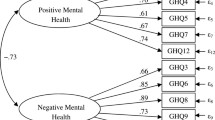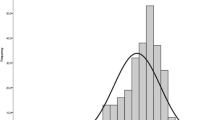Abstract
Studies have consistently demonstrated a reciprocal relationship between internalizing disorders and several chronic physical health conditions. Yet, much of the extant literature fails to take into account the role of comorbidity among internalizing disorders when examining the relationship with poor physical health. The current study applied latent variable modelling to investigate the shared and specific relationships between internalizing (fear and distress factors) and a range of physical health conditions. Data comprised 8841 respondents aged 16–85 years who took part in the 2007 Australian National Survey of Mental Health and Wellbeing. Multiple indicator, multiple causes models were used to parse the shared and specific relationships between internalizing disorders and variables associated with poor physical health. The study found that several physical conditions were significantly related to mean levels of fear and distress. The results were broadly similar but minor differences emerged depending on whether lifetime or past 12 months indicators of mental disorders and physical conditions were utilized in the model. Finally, the results demonstrated that the association between individual mental disorders and physical health conditions are better accounted for by indirect relationships with broad transdiagnostic dimensions rather than including additional disorder-specific relationships. The results indicate that researchers should focus on common mechanisms across multiple internalizing disorders and poor physical health when developing prevention and treatment initiatives.

Similar content being viewed by others
References
Teesson M, Mitchell PB, Deady M et al (2011) Affective and anxiety disorders and their relationship with chronic physical conditions in Australia: findings of the 2007 National Survey of Mental Health and Wellbeing. Aust N Z J Psychiatry 45:939–946. doi:10.3109/00048674.2011.614590
Whiteford HA, Degenhardt L, Rehm J et al (2013) Global burden of disease attributable to mental and substance use disorders: findings from the global burden of disease study 2010. Lancet 382:1575–1586
Clarke DM (2009) Depression and physical illness: more complex than simple comorbidity. Med J Aust 190:S52–S53
Crane PK (2009) Disability in “pure” and “comorbid” mental and physical conditions. In: Von Korff MR, Scott KM, Gureje O (eds) Global perspectives on mental-physical comorbidity in the WHO World Mental Health Surveys. Cambridge University Press, New York, pp 239–248
Lahey BB, Zald DH, Hakes JK et al (2014) Patterns of heterotypic continuity associated with the cross-sectional correlational structure of prevalent mental disorders in adults. JAMA psychiatry 60637:1–8. doi:10.1001/jamapsychiatry.2014.359
Courtney KE, Polich J (2009) Binge drinking in young adults: data, definitions, and determinants. Psychol Bull 135:142–156. doi:10.1037/a0014414
Kessler RC, Chiu W, Demler O, Walters EE (2005) Prevalence, severity, and comorbidity of 12-month DSM-IV disorders in the national comorbidity survey replication. Arch Gen Psychiatry 62:617–627. doi:10.1001/archpsyc.62.6.617
Andrews G, Goldberg DP, Krueger RF et al (2009) Exploring the feasibility of a meta-structure for DSM-V and ICD-11: could it improve utility and validity? Psychol Med 39:1993
Goldberg DP, Krueger RF, Andrews G et al (2009) Emotional disorders: cluster 4 of the proposed meta-structure for DSM-V and ICD-11. Psychol Med 39:2043. doi:10.1017/S0033291709990298
Hettema JM, Neale MC, Myers JM et al (2006) A population-based twin study of the relationship between neuroticism and internalizing disorders. Am J Psychiatry 163:857–864
Kendler KS, Prescott CA, Myers J, Neale MC (2003) The structure of genetic and environmental risk factors for common psychiatric and substance use disorders in men and women. Arch Gen Psychiatry 60:929–937
Krueger RF (1999) The structure of common mental disorders. Arch Gen Psychiatry 56:921–926
Krueger RF, McGue M, Iacono WG (2001) The higher-order structure of common DSM mental disorders: internalization, externalization, and their connections to personality. Personal Individ Differ 30:1245–1259
Slade T, Watson D (2006) The structure of common DSM-IV and ICD-10 mental disorder in the Australian general population. Psychol Med 36:1593–1600
Wright AGC, Krueger RF, Hobbs MJ et al (2012) The structure of psychopathology: toward an expanded quantitative empirical model. J Abnorm Psychol 122:281–294
Kotov R, Krueger RF, Watson D et al (2017) The Hierarchical Taxonomy of Psychopathology (HiTOP): a dimensional alternative to traditional nosologies. J Abnorm Psychol 126:454–477. doi:10.1037/abn0000258
Slade T (2007) The descriptive epidemiology of internalizing and externalizing psychiatric dimensions. Soc Psychiatry Psychiatr Epidemiol 42:554–560
Eaton NR, Krueger RF, Markon KE et al (2013) The structure and predictive validity of the internalizing disorders. J Abnorm Psychol 122:86–92
Australian Bureau of Statistics (2009) National Survey of Mental Health and Wellbeing: user’s guide, 2007. Australian Bureau of Statistics, Canberra
Kessler RC, Üstün BB (2004) The world Mental Health (WMH) Survey initiative version of the world health organization (WHO) composite international diagnostic interview (CIDI). Int J Methods Psychiatr Res 13:93–117. doi:10.1002/mpr.168
Degenhardt L, Hall W (2001) The relationship between tobacco use, substance-use disorders and mental health: results from the National Survey of Mental Health and Well-being. Nicotine Tob Res 3:225–234. doi:10.1080/14622200110050457
Lasser K, Boyd JW, Woolhandler S et al (2000) Smoking and mental illness. JAMA 284:2606. doi:10.1001/jama.284.20.2606
Sturm R (2002) The effects of obesity, smoking, and drinking on medical problems and costs. Health Aff (Millwood) 21:245–253. doi:10.1377/HLTHAFF.21.2.245
Scott KM, Bruffaerts R, Simon GE et al (2008) Obesity and mental disorders in the general population: results from the world mental health surveys. Int J Obes 32:192–200. doi:10.1038/sj.ijo.0803701
Muthen LK, Muthen BO (2015) Mplus users’ guide. Muthen & Muthen, Los Angeles
Krueger RF, Markon KE (2006) Reinterpreting comorbidity: a model-based approach to understanding and classifying psychopathology. Annu Rev Clin Psychol 2:111–133
Hu L, Bentler PM (1999) Cutoff criteria for fit indexes in covariance structure analysis: conventional criteria versus new alternatives. Struct Equ Model 6:1–55
Markon KE, Krueger RF (2004) An empirical comparison of information-theoretic selection criteria for multivariate behavior genetic models. Behav Genet 34:593–610
Raftery AE (1995) Bayesian model selection in social research. Sociol Methodol 25:111–163
Baumeister D, Russell A, Pariante CM, Mondelli V (2014) Inflammatory biomarker profiles of mental disorders and their relation to clinical, social and lifestyle factors. Soc Psychiatry Psychiatr Epidemiol 49:841–849. doi:10.1007/s00127-014-0887-z
Steptoe A, Hamer M, Chida Y (2007) The effects of acute psychological stress on circulating inflammatory factors in humans: a review and meta-analysis. Brain Behav Immun 21:901–912. doi:10.1016/j.bbi.2007.03.011
Raison CL, Capuron L, Miller AH (2006) Cytokines sing the blues: inflammation and the pathogenesis of depression. Trends Immunol 27:24–31. doi:10.1016/j.it.2005.11.006
O’Connor KA, Johnson JD, Hansen MK et al (2003) Peripheral and central proinflammatory cytokine response to a severe acute stressor. Brain Res 991:123–132
Conway CC, Hammen C, Brennan PA (2012) Expanding stress generation theory: test of a transdiagnostic model. J Abnorm Psychol 121:754–766. doi:10.1037/a0027457
McLaughlin KA, Nolen-Hoeksema S (2011) Rumination as a transdiagnostic factor in depression and anxiety. Behav Res Ther 49:186–193. doi:10.1016/j.brat.2010.12.006
Campayo A, de Jonge P, Roy JF et al (2010) Depressive disorder and incident diabetes mellitus: the effect of characteristics of depression. Am J Psychiatry 167:580–588. doi:10.1176/appi.ajp.2009.09010038
Kruse J, Schmitz N, Thefeld W (2003) On the association between diabetes and mental disorders in a community sample. Diabetes Care 26:1841–1846
Saydah SH, Brancati FL, Golden SH et al (2003) Depressive symptoms and the risk of type 2 diabetes mellitus in a US sample. Diabetes Metab Res Rev 19:202–208. doi:10.1002/dmrr.353
Strine TW, Mokdad AH, Dube SR et al (2008) The association of depression and anxiety with obesity and unhealthy behaviors among community-dwelling US adults. Gen Hosp Psychiatry 30:127–137. doi:10.1016/j.genhosppsych.2007.12.008
Farchione TJ, Fairholme CP, Ellard KK et al (2012) Unified protocol for transdiagnostic treatment of emotional disorders: a randomized controlled trial. Behav Ther 43:666–678. doi:10.1016/j.beth.2012.01.001
Author information
Authors and Affiliations
Corresponding author
Ethics declarations
Conflict of interest
On behalf of all authors, the corresponding author states that there is no conflict of interest.
Rights and permissions
About this article
Cite this article
van de Pavert, I., Sunderland, M., Luijten, M. et al. The general relationship between internalizing psychopathology and chronic physical health conditions: a population-based study. Soc Psychiatry Psychiatr Epidemiol 52, 1257–1265 (2017). https://doi.org/10.1007/s00127-017-1422-9
Received:
Accepted:
Published:
Issue Date:
DOI: https://doi.org/10.1007/s00127-017-1422-9




